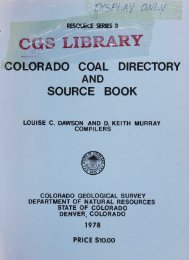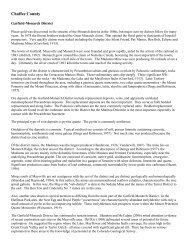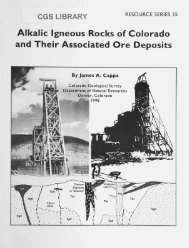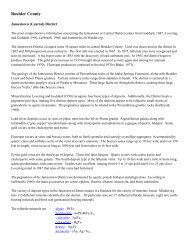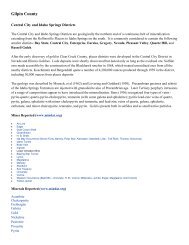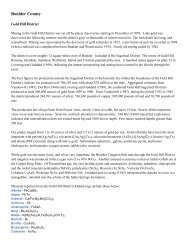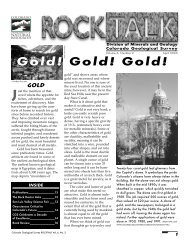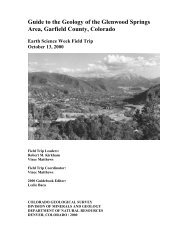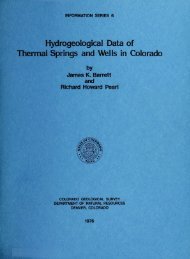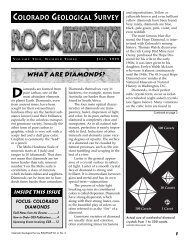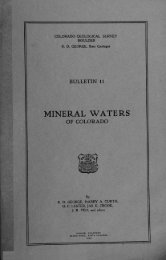Marble - Colorado Geological Survey
Marble - Colorado Geological Survey
Marble - Colorado Geological Survey
Create successful ePaper yourself
Turn your PDF publications into a flip-book with our unique Google optimized e-Paper software.
night can be more pronounced in winter due to<br />
solar warming of air and thermal inversion.<br />
Tree cover in the Conundrum Valley is<br />
restricted to elevations below about 10,800 feet.<br />
Mature stands of coniferous trees are few but<br />
do occur in certain areas. Large aspen groves<br />
thrive on the valley floor and up either valley<br />
slope. Due to the number of avalanche chutes,<br />
a large percentage of the lower valley supports<br />
ground vegetation only. Much of the terrain is<br />
above timberline and is sparsely vegetated.<br />
Area History<br />
Pitkin County and the Aspen area were originally<br />
developed as a mining center in the 1880s<br />
when rich silver-lead-zinc ore was discovered<br />
nearby. The mines of Aspen flourished for a<br />
time until the demonetization of silver in 1893<br />
caused a gradual decline in activity.<br />
Other areas in and around the Elk Mountains<br />
were also being settled to exploit the rich<br />
mineral wealth which was becoming evident. In<br />
the Crystal River valley to the west, potentially<br />
economic deposits of copper, iron, gold, sulphur,<br />
coal, slate, and marble were being recognized,<br />
in addition to silver-lead-zinc. By 1897, two smelters<br />
were processing the variety of ores being<br />
mined in the valley. This rejuvenated the crippled<br />
economy in the aftermath of the silver panic<br />
for a time. The revival of metal mining was<br />
to be short lived, prompting the local inhabitants<br />
to look to the deposits of white marble<br />
known to occur in the valley for the next "boom''.<br />
The first claims located on the white marble<br />
deposits of Yule Creek were staked in 1886, with<br />
some minor development commencing immediately<br />
(Vandenbusche and Myers, 1970). Production<br />
was hampered by harsh working and transportation<br />
conditions and by a lack of capital to<br />
develop the quarries properly. It would be another<br />
seven years before any substantial capital<br />
was attracted to the marble operations and<br />
another 15 years before they were fully developed<br />
(Vandenbusche and Myers, 1970). Yule<br />
Creek marble proved to be of a superior quality,<br />
rivaling that of any marble found in the world.<br />
Its extreme strength and aesthetic quality placed<br />
a high demand on Yule Creek stone, and it was<br />
eventually used in numerous constructions in<br />
the United States and abroad, including the<br />
Lincoln Memorial in Washington D.C.<br />
The blue-gray marble of Conundrum Creek,<br />
which is subject of this report, was slated for<br />
development in the years 1911-1912. The<br />
placer claims: Edith M, Vera, and Vermont, all<br />
patented in February 1899, were laid out adjacent<br />
to and contiguous with the California<br />
placer, patented April 1891. These four claims,<br />
comprising 472 acres, were the major holding of<br />
the <strong>Colorado</strong>-Highland <strong>Marble</strong> Corporation,<br />
incorporated in 1912 under the laws of <strong>Colorado</strong><br />
with a capital stock of $10,000,000 (Rocky<br />
Mountain News, 1912). The company did manage<br />
to receive and install equipment at the site<br />
including a boiler, two hoists, and two channeling<br />
machines. Production was limited to two<br />
small quarry benches and no record exists of<br />
marble being shipped from the property (see<br />
Figure 2). The property has remained idle<br />
except for some minor attempts at gold placering<br />
on the California claim.<br />
INVESTIGATIONS SUMMARY<br />
Project Objectives<br />
The <strong>Colorado</strong> <strong>Geological</strong> <strong>Survey</strong> (CGS) was<br />
contracted by the U.S. Forest Service through<br />
the U.S. <strong>Geological</strong> <strong>Survey</strong> to conduct a<br />
mineral appraisal of privately held mineral<br />
rights located in the Snowmass Wilderness<br />
Area. The contract calls for an economic<br />
analysis to determine the Net Present Value<br />
(NPV) using the Discounted Cash Flow Rate of<br />
Return (DCFROR). The objective of this study<br />
was to arrive at a valuation for the U.S. Forest<br />
Service of this mineral estate or to identify and<br />
recommend courses of action which would lead<br />
to the completion of such a valuation. The CGS<br />
understood that time is of the essence, and that<br />
the project must be completed immediately<br />
following the 1989 field season. No motorized<br />
equipment would be used to collect samples by<br />
rotary drilling, core drilling, trenching, mining,<br />
or any other methods generally used when<br />
conducting a mineral appraisal.<br />
3



